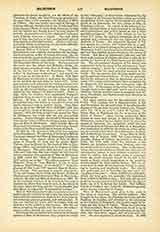

Maina Indians (also MAYNA), a group of tribes constituting a distinct linguistic stock, the Mainan, ranging along the north bank of the Maranon. Their earlier habitat is supposed to have been on the upper waters of the Morona and Pastaza, Ecuador. Brinton gives them six tribes, or dialects, viz.: Cahuapana, Chapa, Chayavita, Coronado, Humurano, Maina, Roamaina. Hervas gives them two languages in six dialects, viz.: Maina (Chapo, Coronado, Humurano, Roamaino dialects) and Chayavita (Cahuapano and Paranapuro dialects). The Maina are notable as having been the first tribes of the upper Amazon region to be evangelized, so that they gave their name to the whole mission jurisdiction of the region and to the later province of Mainas, which included the larger part of the present Ecuador and northern Peru, east of the main Cordillera, including the basins of the Huallaga and Ucayali. In this missionary province of Mainas, according to Hervas, there labored from 1638 to the expulsion in 1767, 157 Jesuit missionaries of Quito, who founded 152 missions, and eight of whom won the palm of martyrdom. The work was begun in 1638 by the Jesuit Fathers Gaspar de Cuxia and Lucas de la Cueva, from Quito, who, beginning their labor at the new town of San Francisco de Borja (now Borja) on the north bank of the Maranon below the junction of the Santiago, established by themselves and their successors from the Quito province, a series of missions extending down the river on both sides. In 1682 Rodriguez enumerates three missions of the Maina proper, in proximity to Borja, and one each of the Chayavita Coronados, Paranapura, and Roamaina besides others in the surrounding tribes. In 1798 Hervas names San Ignacio, San Juan, Conception, Presentacion, and presumably San Borja, as missions occupied by Maina tribes. All the missions were then far on the decline, which he ascribes chiefly to the repeated inroads of the Brazilian slave hunters (see Mameluco). The mission population is now either extinct or assimilated with the general civilized population, but a few untamed bands still roam the forests.
JAMES MOONEY

